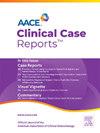Improvement of Glycogenic Hepatopathy With Minimal Corresponding Improvement of Glycemic Control in a Person With Type 1 Diabetes: Case Report and Literature Review
IF 1.2
Q3 Medicine
引用次数: 0
Abstract
Background/Objective
Glycogenic hepatopathy is characterized by diffuse glycogen accumulation in hepatocytes that leads to hepatomegaly and elevated transaminases. Notably, the condition is reversible as improving glycemic control has been shown to resolve glycogenic hepatopathy and provide symptomatic relief.
Case Report
A 30-year-old female with longstanding and poorly-controlled type 1 diabetes presented to her primary care physician for a routine follow-up visit. Routine lab work demonstrated hyperglycemia and elevated liver enzymes (alkaline phosphatase of 180 U/L, aspartate aminotransferase of 111 U/L, and alanine aminotransferase of 101 U/L). At laboratory reassessment 3 weeks later, liver function tests remained elevated and hepatic ultrasound was unrevealing. She was referred to gastroenterology for further evaluation and laboratory tests for viral and autoimmune hepatitis were negative while magnetic resonance imaging of the abdomen was unremarkable. Given the nondiagnostic work-up, liver biopsy was performed and pathology was consistent with glycogenic hepatopathy. She was referred to Endocrinology for improved glycemic control; however, liver enzymes normalized over the next several months despite minimal improvement in glycemic control. She was eventually transitioned to a closed-loop automated insulin delivery system and started dulaglutide for management of obesity. Subsequent A1c values significantly improved and liver enzymes remained within normal limits.
Discussion
This case raises awareness of an under recognized complication of type 1 diabetes and challenges conventional thinking about factors leading to its resolution.
Conclusion
Further investigation into the underlying pathophysiology of glycogenic hepatopathy is needed.
1型糖尿病患者糖原性肝病的改善与相应的血糖控制改善:病例报告和文献回顾
背景/目的糖原性肝病的特点是肝细胞弥漫性糖原积聚,导致肝肿大和转氨酶升高。值得注意的是,这种情况是可逆的,因为改善血糖控制已被证明可以解决糖原性肝病并提供症状缓解。病例报告一名患有长期控制不良的1型糖尿病的30岁女性向她的初级保健医生进行常规随访。常规实验室检查显示高血糖和肝酶升高(碱性磷酸酶180 U/L,天冬氨酸转氨酶111 U/L,丙氨酸转氨酶101 U/L)。3周后实验室复查,肝功能检查仍升高,肝脏超声未见异常。她被转到胃肠病学做进一步的评估,病毒性肝炎和自身免疫性肝炎的实验室检查呈阴性,而腹部磁共振成像无明显异常。鉴于非诊断性检查,进行了肝活检,病理符合糖原性肝病。她被转到内分泌科以改善血糖控制;然而,在接下来的几个月里,肝酶恢复正常,尽管血糖控制的改善很小。她最终转为使用闭环自动胰岛素输送系统,并开始使用杜拉鲁肽治疗肥胖。随后的A1c值显著改善,肝酶保持在正常范围内。本病例提高了人们对1型糖尿病并发症的认识,并对导致其解决的因素的传统思维提出了挑战。结论糖原性肝病的病理生理机制有待进一步研究。
本文章由计算机程序翻译,如有差异,请以英文原文为准。
求助全文
约1分钟内获得全文
求助全文
来源期刊

AACE Clinical Case Reports
Medicine-Endocrinology, Diabetes and Metabolism
CiteScore
2.30
自引率
0.00%
发文量
61
审稿时长
55 days
 求助内容:
求助内容: 应助结果提醒方式:
应助结果提醒方式:


